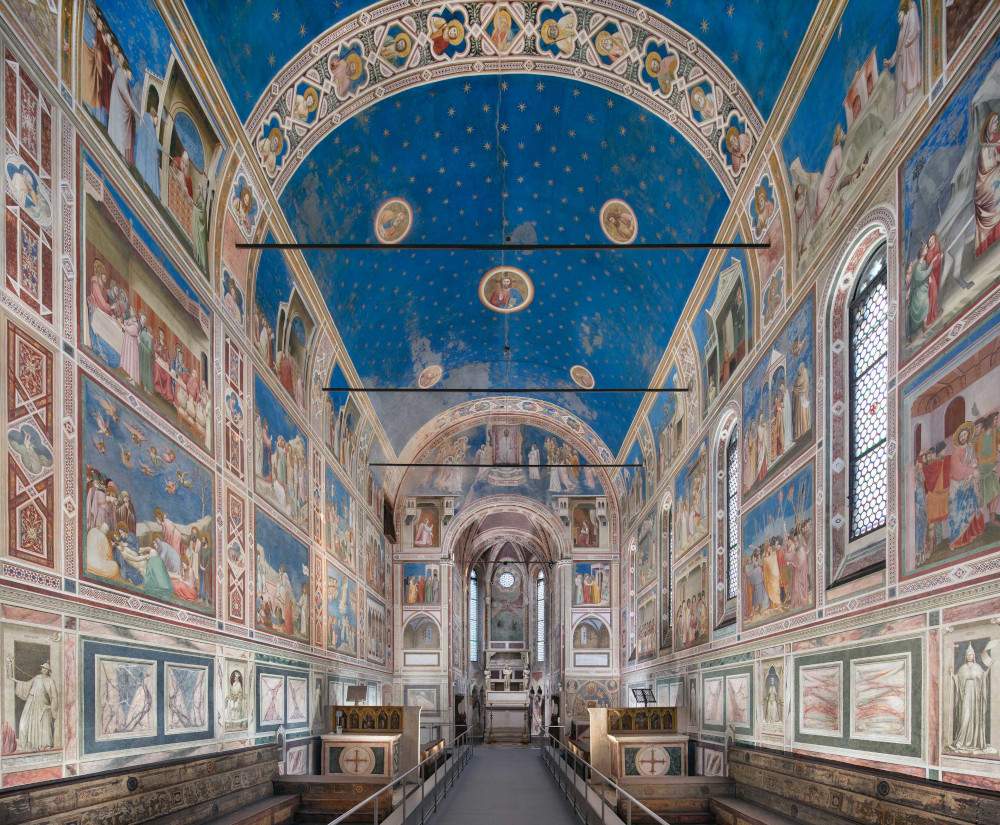Art Night: blue in the history of art, from prehistory to today
On Friday, Feb. 11, 2022, a new episode of Art Night, the program hosted by Neri Marcorè, Silvia De Felice and Emanuela Avallone, Massimo Favia, and Alessandro Rossi, and directed by Andrea Montemaggiori, will be aired in its world premiere on Rai5. This week they wanted to try to tell the story of art starting from one color: blue.
The evening therefore begins at 9:15 p.m. with Blue. The Colors of Art, a documentary by Mark on video produced in collaboration with Rai Cultura. The history of blue is fascinating: nonexistent in prehistoric times, little loved by the Greeks and Romans who preferred it to red as a symbol of royalty, in the Middle Ages it became the color of the kings of France and of the Virgin’s mantle, of the starry vaults of Byzantine mosaics and of Giottesque skies; it even depopulated in the Renaissance, where the cost of ultramarine blue was very often paid for by the patrons, in the contracts of the great painters. Today, surveys say, it is the favorite color of the West. The documentary intends to tell the story of a color that spans the entire history of art, not just Western art, and the history of the world, arriving at exceptional locations, from Neolithic wall paintings in Rignano Garganico to the Egyptian Museum in Turin, where director Christian Greco will talk about Egyptian blue, humanity’s first artificial pigment. We will then move on to the Scrovegni Chapel in Padua, the Basilica of Assisi, and the Gallery of Modern and Contemporary Art in Rome, where precious paintings in which blue is the protagonist are preserved, by artists such as Monet, Cezanne, and the work 32 square meters of sea by Pino Pascali. Finally, we will go to Villa Farnesina in Rome, where the Academician of the Lincei, Antonio Sgamellotti, discovered the use of Egyptian blue in Raphael’s Triumph of Galatea.
Blue has always been a difficult, elusive pigment: from lapis lazuli blue, or ultramarine, from the mountains of Afghanistan and more expensive than gold, to Egyptian blue, humanity’s first artificial color, created nearly five thousand years before the invention of chemistry; from eighteenth-century artificial blues, such as Prussian blue, cobalt blue, and Bremen blue, which served the Impressionists for their famous colored shadows, to the discovery ofYlnMn, a stable and brilliant blue discovered by accident by Mas Subramanian, Distinguished Professor at Oregon State University in Corvallis, who was exceptionally interviewed for this documentary.
Plus images from the Fausto Levi Synagogue in Soragna (Parma), the ford plantations in Ancona, the Diocesan Museum and Art Gallery in Ancona, the Oratory of San Giovanni and Botanical Garden in Urbino, and the Maimeri Color Factory in Turin. And interviews with Sandro Baroni (lecturer in Artistic Techniques at the Milano Painting Academy), Francesca Capanna (Director of the School of Higher Education of the Central Institute for Restoration), Carlo Giantomassi (restorer), Ulderico Santamaria (lecturer Materials Science University of Tuscia), Roberta Tonnarelli (conservator Synagogue Jewish Museum Fausto Levi of Soragna), Massimo Baldini (master dyer), Virginia Lapenta (curator at Villa Farnesina - Rome), Gianni Maimeri (Maimeri Foundation), Chiara Stefani and Giovanna Coltelli (art historians National Gallery of Modern and Contemporary Art - Rome), Paola Carnazza, (restorer of the National Gallery of Modern and Contemporary Art - Rome), Vittoria Coen (art historian and critic).
Art Night will continue with the documentary Ettore Spalletti. As it is, dedicated to one of the great names in world contemporary art, one of the most appreciated sculptors and painters of the 20th century.
 |
| Art Night: blue in the history of art, from prehistory to today |
Warning: the translation into English of the original Italian article was created using automatic tools. We undertake to review all articles, but we do not guarantee the total absence of inaccuracies in the translation due to the program. You can find the original by clicking on the ITA button. If you find any mistake,please contact us.





























